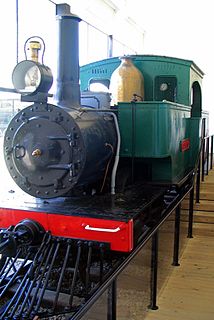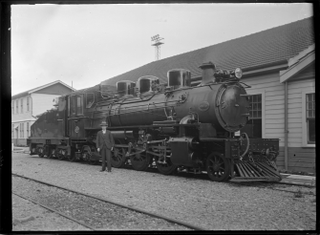
The Ferrymead Railway is a New Zealand heritage railway built upon the track formation of New Zealand's first public railway, from Ferrymead to Christchurch, which opened on 1 December 1863. On the opening of the line to Lyttelton on 9 December 1867, the Ferrymead Railway became the Ferrymead Branch and was closed shortly thereafter. In 1964, rail enthusiasts began relaying track on the historic formation and the new 3 ft 6 in narrow gauge. Ferrymead Railway officially reopened in 1977. It now operates steam, diesel and electric trains regularly and is recognised as one of the most significant rail preservation sites in New Zealand.

Railway preservation in New Zealand is the preservation of historically significant facets of New Zealand's rail transport history. The earliest recorded preservation attempt took place in 1925, although the movement itself did not start properly until 1960.

The New Zealand F class was the first important class of steam locomotive built to operate on New Zealand's railway network after the national gauge of 3 ft 6 in was adopted. The first locomotives built for the new gauge railways were two E class double Fairlies for the Dunedin and Port Chalmers Railway Company. The F class was the first class ordered by the central government, and between 1872 and 1888, a total of eighty-eight members of the class were constructed.

The NZR A class of 1873 consisted of three types of steam locomotives used on New Zealand's railway network of similar specification but differing detail. The first and most numerous were from the Dübs and Company, the next from the Wellington firm E.W. Mills Lion Foundry, and the last from the Scottish firm of Shanks. The specifications are for the Dubs Yorkshire engines.

The NZR A class were a class of steam locomotives built in 1906 with a 4-6-2 wheel arrangement for the New Zealand Railways Department (NZR). The class should not be confused with the older and more obscure A class of 1873. They were designed by the NZR's Chief Mechanical Engineer, A. L. Beattie and his Chief Draughtsman, G. A. Pearson to replace less powerful locomotives struggling with increasing loads on the South Island Main Trunk Railway, and in anticipation of the traffic volumes that would be created upon the completion of the North Island Main Trunk Railway.

The NZR WD class was a class of tank locomotive built by Baldwin Locomotive Works to operate on New Zealand's national rail network.

The NZR E class of Double Fairlie steam locomotives were two different types of Fairlie steam locomotives, used on New Zealand's railway network.

The New Zealand X class was a pioneering class of eighteen 4-8-2 steam locomotives built for New Zealand Railways Department (NZR) and designed by A. L. Beattie that operated on the national rail network of New Zealand. In 1908, a heavy and powerful locomotive was required to haul traffic on the newly completed mountainous central section of the North Island Main Trunk Railway, and as a logical progression of the 4-6-2 Q class design, the 4-8-2 wheel arrangement was created for the X class.

The NZR C class consisted of twenty-four steam locomotives built to perform shunting duties on New Zealand's national rail network. It is sometimes known as the big C class to differentiate it from the C class of 1873.

The NZR WAB class locomotives were steam locomotives designed, built and used by New Zealand Railways Department (NZR). Their wheel arrangement is described by the Whyte notation 4-6-4T. The locomotives were designed by NZR chief draughtsman S.H. Jenkinson as tank versions of the AB class 4-6-2 Pacific locomotive. Initially, the locomotives were separated into two classes, designated WAB for mainline work and WS for suburban work.

The NZR JA class were a type of 4-8-2 steam locomotive used on the New Zealand railway network. The class was built in two batches, the first batch was built at Dunedin's Hillside Workshops between 1946 and 1956 and the second batch by the North British Locomotive Works in 1951. To distinguish between the batches, locomotives are identified by their maker.

The New Zealand EW class locomotive was a type of electric locomotive used in Wellington, New Zealand. The classification "EW" was due to their being electric locomotives allocated to Wellington. For two decades until the advent of the DX class they were the most powerful locomotives in New Zealand.

The NZR EO class of 1923 were electric locomotives used on the steep Otira to Arthurs Pass section of the Midland Line in New Zealand. They were primarily needed for pulling trains through the 1 in 33 grade 8.5 km (5.3 mi) Otira Tunnel which was too long and steep to allow steam locomotives to be used.

The NZR J class steam locomotives were a type of 4-8-2 steam locomotive built for the New Zealand Railways Department (NZR) and used on the New Zealand railway network. Built by the North British Locomotive Works, although designed to work on the lighter secondary lines the class was frequently used on mainline express passenger trains as well as freight. The class first appeared in distinctive streamlining, which was later removed from 1947 onwards for maintenance reasons. The class should not be confused with the earlier 1874 J class. Three J class lasted until the end of steam-hauled services on 26 October 1971, three locomotives of the forty built have been preserved.

The NZR LA class was a class of 4-4-0T steam locomotives used by the New Zealand Railways Department and the New Zealand Midland Railway Company. They were built by Nasmyth, Wilson and Company in 1887 for New Zealand Midland Railway Company, and were taken over by NZR in 1900, when the government acquired the incomplete Midland line. The designation also applies to the NZR 4-4-0Trebuilds of the Avonside L class of 1875 which were later reclassified LB after being rebuilt as 4-4-2Ts.

The New Zealand DE class locomotive is a New Zealand class of shunting diesel-electric locomotives. The New Zealand Railways intended to replace steam locomotives for shunting duties with this class. They are physically similar to the Tasmanian Government Railways X class, which were also of English Electric design.

The NZR KB class of 1939 was a class of six mixed traffic steam locomotives built for New Zealand Railways Department (NZR), that operated on New Zealand's railway network. After the success of the K class, the KB class were built to meet the increasing traffic demands on the Midland Line in the South Island. The locomotives had a wheel arrangement of 4-8-4 and first appeared with distinctive streamlining, mainly to hide their ACFI feedwater systems.

NZR D class steam tank locomotives operated on New Zealand's national railway network. The first entered service in 1874 all had been withdrawn by the end of 1927, which allowed the D classification to be used again in 1929.
The NZR WA class locomotives were a class of Tank locomotive built for use for New Zealand Railways (NZR). 11 were built in-house at the Addington Workshops and at Hillside Workshops. Four more were converted from old J class 2-6-0 locomotives.
The Ferrymead 125 celebration was an event to celebrate 125 years of Rail transport in New Zealand. The event was held over a week from 17 to 24 October 1988, with trains running in, and to and from Christchurch.

















